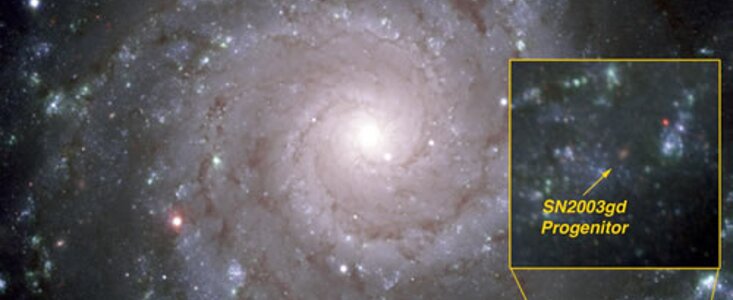Disappearing Supernovae Stars
17 Marzo 2009
In a paper published in the March 19, 2009 issue of Science Express, Justyn Maund and Stephen Smartt present data from the Gemini Observatory and Hubble Space Telescope (HST) that confirms the disappearance of the progenitors of two Type II supernovae (SNe).
The only other supernova progenitor of this sort known to have definitively disappeared was SN 1987A in the Large Magellanic Cloud, part of our Local Group of Galaxies. Because the identity of the stars found in pre-explosion images has now been confirmed, this work provides the important “nail in the coffin” that the now missing Red Supergiants were the progenitors.
The two supernovae, denoted 1993J and 2003gd, both had confirmed pre-existing progenitors identified from archival data which allowed the researchers to compare pre-supernova identification of the progenitor star with post-supernova observations. Maund and Smartt used a technique where images were taken after SN 2003gd had faded away, and the progenitor star was presumably missing, and subtracted from the pre-explosion images. Anything left over at the SN position corresponded to the real progenitor star. The Gemini observations of 2003gd are shown in Figure 1 which compares pre- and post-supernova views of the progenitor star’s region of the galaxy know as M-74 or NGC 628. Figure 2 shows the images from the Science Express paper with both the Gemini and HST data.
“This is the first red supergiant progenitor for a normal Type IIP supernova which has been shown to have disappeared and it's at the low mass end of the scale for massive stars to explode as supernovae,” said Maund. “So, it finally confirms that a standard prediction of a number of stellar evolution models is correct.”
Red Supergiants are massive stars, like Betelgeuse in the constellation of Orion, that are at least eight times more massive than the Sun and have 500 times larger diameter. They explode as Supernovae once they exhaust their supply of fuel and can no longer hold themselves up against their own gravity. Having exploded in 2003, the matter the was once inside the red supergiant progenitor of SN 2003gd is now being dispersed in its host galaxy to help form the next generation of stars.
All of the data for the study of SN 1993J (located in the galaxy M-81 or NGC 3031) were obtained with HST. The progenitor for this star was a binary system that exploded in a Hydrogen-bearing (Type IIB) supernova. The star that exploded has now disappeared, but its companion star, which stole most of the mass from the progenitor, is still there in the debris of the SN explosion.
The paper "The Disappearance of the Progenitors of Supernovae 1993J and 2003gd" is published in Science, 324:486-488, April 24, 2009. See the Science Express abstract with a link to the paper here.
Justyn Maund is a researcher at the Dark Cosmology Centre, Niels Bohr Institute, University of Copenhagen, Denmark and the University of California Santa Cruz. Stephen Smartt is at the Astrophysics Research Centre, School of Mathematics and Physics, Queens’ University Belfast, United Kingdom.



